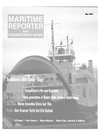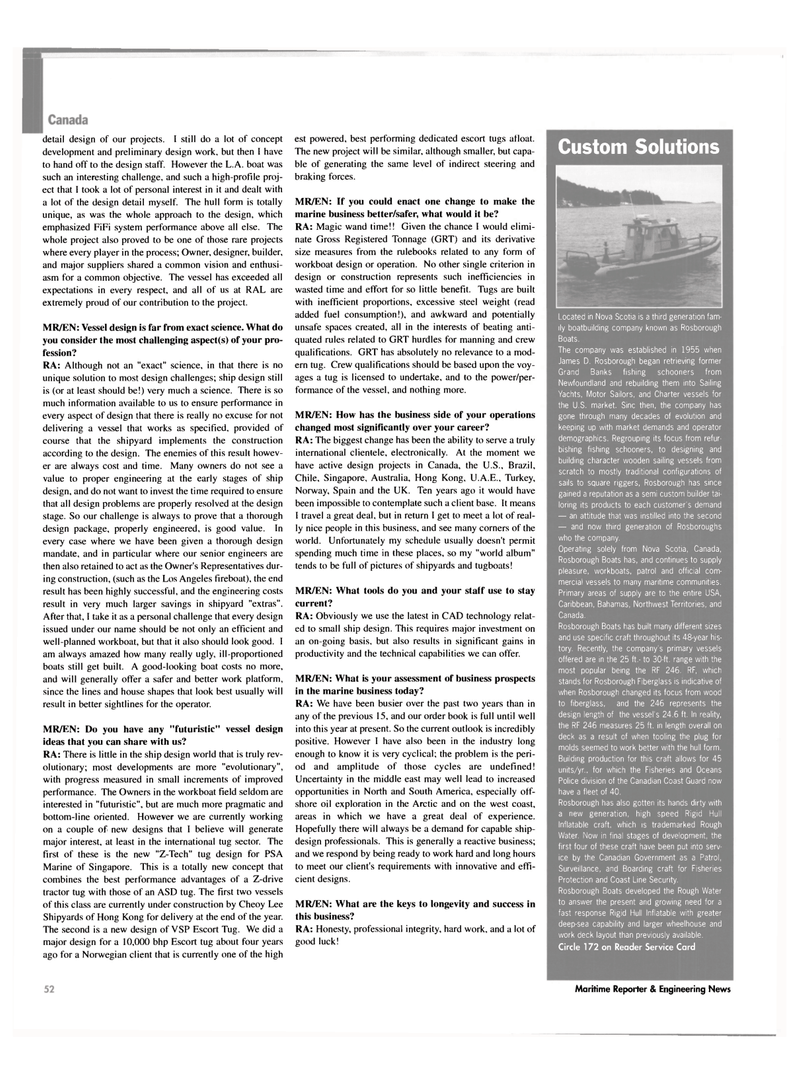
Page 48: of Maritime Reporter Magazine (May 2003)
Read this page in Pdf, Flash or Html5 edition of May 2003 Maritime Reporter Magazine
detail design of our projects. I still do a lot of concept development and preliminary design work, but then I have to hand off to the design staff. However the L.A. boat was such an interesting challenge, and such a high-profile proj- ect that I took a lot of personal interest in it and dealt with a lot of the design detail myself The hull form is totally unique, as was the whole approach to the design, which emphasized FiFi system performance above all else. The whole project also proved to be one of those rare projects where every player in the process; Owner, designer, builder, and major suppliers shared a common vision and enthusi- asm for a common objective. The vessel has exceeded all expectations in every respect, and all of us at RAL are extremely proud of our contribution to the project.
MR/EN: Vessel design is far from exact science. What do you consider the most challenging aspect(s) of your pro- fession?
RA: Although not an "exact" science, in that there is no unique solution to most design challenges; ship design still is (or at least should be!) very much a science. There is so much information available to us to ensure performance in every aspect of design that there is really no excuse for not delivering a vessel that works as specified, provided of course that the shipyard implements the construction according to the design. The enemies of this result howev- er are always cost and time. Many owners do not see a value to proper engineering at the early stages of ship design, and do not want to invest the time required to ensure that all design problems are properly resolved at the design stage. So our challenge is always to prove that a thorough design package, properly engineered, is good value. In every case where we have been given a thorough design mandate, and in particular where our senior engineers are then also retained to act as the Owner's Representatives dur- ing construction, (such as the Los Angeles fireboat), the end result has been highly successful, and the engineering costs result in very much larger savings in shipyard "extras".
After that, I take it as a personal challenge that every design issued under our name should be not only an efficient and well-planned workboat, but that it also should look good. I am always amazed how many really ugly, ill-proportioned boats still get built. A good-looking boat costs no more, and will generally offer a safer and better work platform, since the lines and house shapes that look best usually will result in better sightlines for the operator.
MR/EN: Do you have any "futuristic" vessel design ideas that you can share with us?
RA: There is little in the ship design world that is truly rev- olutionary; most developments are more "evolutionary", with progress measured in small increments of improved performance. The Owners in the workboat field seldom are interested in "futuristic", but are much more pragmatic and bottom-line oriented. However we are currently working on a couple of new designs that I believe will generate major interest, at least in the international tug sector. The first of these is the new "Z-Tech" tug design for PSA
Marine of Singapore. This is a totally new concept that combines the best performance advantages of a Z-drive tractor tug with those of an ASD tug. The first two vessels of this class are currently under construction by Cheoy Lee
Shipyards of Hong Kong for delivery at the end of the year.
The second is a new design of VSP Escort Tug. We did a major design for a 10,000 bhp Escort tug about four years ago for a Norwegian client that is currently one of the high est powered, best performing dedicated escort tugs afloat.
The new project will be similar, although smaller, but capa- ble of generating the same level of indirect steering and braking forces.
MR/EN: If you could enact one change to make the marine business better/safer, what would it be?
RA: Magic wand time!! Given the chance I would elimi- nate Gross Registered Tonnage (GRT) and its derivative size measures from the rulebooks related to any form of workboat design or operation. No other single criterion in design or construction represents such inefficiencies in wasted time and effort for so little benefit. Tugs are built with inefficient proportions, excessive steel weight (read added fuel consumption!), and awkward and potentially unsafe spaces created, all in the interests of beating anti- quated rules related to GRT hurdles for manning and crew qualifications. GRT has absolutely no relevance to a mod- ern tug. Crew qualifications should be based upon the voy- ages a tug is licensed to undertake, and to the power/per- formance of the vessel, and nothing more.
MR/EN: How has the business side of your operations changed most significantly over your career?
RA: The biggest change has been the ability to serve a truly international clientele, electronically. At the moment we have active design projects in Canada, the U.S., Brazil,
Chile. Singapore, Australia, Hong Kong, U.A.E., Turkey,
Norway, Spain and the UK. Ten years ago it would have been impossible to contemplate such a client base. It means
I travel a great deal, but in return I get to meet a lot of real- ly nice people in this business, and see many corners of the world. Unfortunately my schedule usually doesn't permit spending much time in these places, so my "world album" tends to be full of pictures of shipyards and tugboats!
MR/EN: What tools do you and your staff use to stay current?
RA: Obviously we use the latest in CAD technology relat- ed to small ship design. This requires major investment on an on-going basis, but also results in significant gains in productivity and the technical capabilities we can offer.
MR/EN: What is your assessment of business prospects in the marine business today?
RA: We have been busier over the past two years than in any of the previous 15, and our order book is full until well into this year at present. So the current outlook is incredibly positive. However I have also been in the industry long enough to know it is very cyclical; the problem is the peri- od and amplitude of those cycles are undefined!
Uncertainty in the middle east may well lead to increased opportunities in North and South America, especially off- shore oil exploration in the Arctic and on the west coast, areas in which we have a great deal of experience.
Hopefully there will always be a demand for capable ship- design professionals. This is generally a reactive business; and we respond by being ready to work hard and long hours to meet our client's requirements with innovative and effi- cient designs.
MR/EN: What are the keys to longevity and success in this business?
RA: Honesty, professional integrity, hard work, and a lot of good luck!
Custom Solutions
Located in Nova Scotia is a third generation fam- ily boatbuilding company known as Rosborough
Boats.
The company was established in 1955 when
James D. Rosborough began retrieving former
Grand Banks fishing schooners from
Newfoundland and rebuilding them into Sailing
Yachts, Motor Sailors, and Charter vessels for the U.S. market. Sine then, the company has gone through many decades of evolution and keeping up with market demands and operator demographics. Regrouping its focus from refur- bishing fishing schooners, to designing and building character wooden sailing vessels from scratch to mostly traditional configurations of sails to square riggers, Rosborough has since gained a reputation as a semi custom builder tai- loring its products to each customer's demand — an attitude that was instilled into the second — and now third generation of Rosboroughs who the company.
Operating solely from Nova Scotia, Canada,
Rosborough Boats has, and continues to supply pleasure, workboats, patrol and official com- mercial vessels to many maritime communities.
Primary areas of supply are to the entire USA,
Caribbean, Bahamas, Northwest Territories, and
Canada.
Rosborough Boats has built many different sizes and use specific craft throughout its 48-year his- tory. Recently, the company's primary vessels offered are in the 25 ft.- to 30-ft. range with the most popular being the RF 246. RF, which stands for Rosborough Fiberglass is indicative of when Rosborough changed its focus from wood to fiberglass, and the 246 represents the design length of the vessel's 24.6 ft. In reality, the RF 246 measures 25 ft. in length overall on deck as a result of when tooling the plug for molds seemed to work better with the hull form.
Building production for this craft allows for 45 units/yr., for which the Fisheries and Oceans
Police division of the Canadian Coast Guard now have a fleet of 40.
Rosborough has also gotten its hands dirty with a new generation, high speed Rigid Hull
Inflatable craft, which is trademarked Rough
Water. Now in final stages of development, the first four of these craft have been put into serv- ice by the Canadian Government as a Patrol,
Surveillance, and Boarding craft for Fisheries
Protection and Coast Line Security.
Rosborough Boats developed the Rough Water to answer the present and growing need for a fast response Rigid Hull Inflatable with greater deep-sea capability and larger wheelhouse and work deck layout than previously available.
Circle 172 on Reader Service Card 48 Maritime Reporter & Engineering News

 47
47

 49
49
